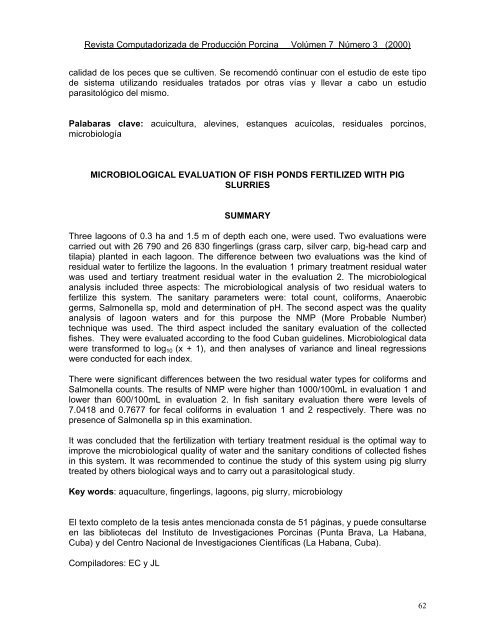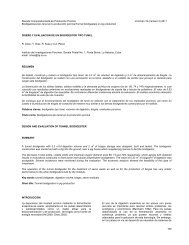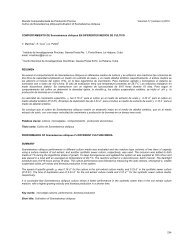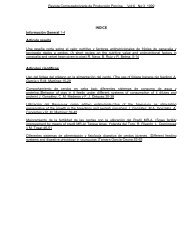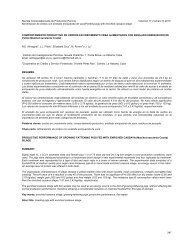Descargar Revista - Instituto de Investigaciones Porcinas (IIP)
Descargar Revista - Instituto de Investigaciones Porcinas (IIP)
Descargar Revista - Instituto de Investigaciones Porcinas (IIP)
Create successful ePaper yourself
Turn your PDF publications into a flip-book with our unique Google optimized e-Paper software.
<strong>Revista</strong> Computadorizada <strong>de</strong> Producción Porcina Volúmen 7 Número 3 (2000)<br />
calidad <strong>de</strong> los peces que se cultiven. Se recomendó continuar con el estudio <strong>de</strong> este tipo<br />
<strong>de</strong> sistema utilizando residuales tratados por otras vías y llevar a cabo un estudio<br />
parasitológico <strong>de</strong>l mismo.<br />
Palabaras clave: acuicultura, alevines, estanques acuícolas, residuales porcinos,<br />
microbiología<br />
MICROBIOLOGICAL EVALUATION OF FISH PONDS FERTILIZED WITH PIG<br />
SLURRIES<br />
SUMMARY<br />
Three lagoons of 0.3 ha and 1.5 m of <strong>de</strong>pth each one, were used. Two evaluations were<br />
carried out with 26 790 and 26 830 fingerlings (grass carp, silver carp, big-head carp and<br />
tilapia) planted in each lagoon. The difference between two evaluations was the kind of<br />
residual water to fertilize the lagoons. In the evaluation 1 primary treatment residual water<br />
was used and tertiary treatment residual water in the evaluation 2. The microbiological<br />
analysis inclu<strong>de</strong>d three aspects: The microbiological analysis of two residual waters to<br />
fertilize this system. The sanitary parameters were: total count, coliforms, Anaerobic<br />
germs, Salmonella sp, mold and <strong>de</strong>termination of pH. The second aspect was the quality<br />
analysis of lagoon waters and for this purpose the NMP (More Probable Number)<br />
technique was used. The third aspect inclu<strong>de</strong>d the sanitary evaluation of the collected<br />
fishes. They were evaluated according to the food Cuban gui<strong>de</strong>lines. Microbiological data<br />
were transformed to log10 (x + 1), and then analyses of variance and lineal regressions<br />
were conducted for each in<strong>de</strong>x.<br />
There were significant differences between the two residual water types for coliforms and<br />
Salmonella counts. The results of NMP were higher than 1000/100mL in evaluation 1 and<br />
lower than 600/100mL in evaluation 2. In fish sanitary evaluation there were levels of<br />
7.0418 and 0.7677 for fecal coliforms in evaluation 1 and 2 respectively. There was no<br />
presence of Salmonella sp in this examination.<br />
It was conclu<strong>de</strong>d that the fertilization with tertiary treatment residual is the optimal way to<br />
improve the microbiological quality of water and the sanitary conditions of collected fishes<br />
in this system. It was recommen<strong>de</strong>d to continue the study of this system using pig slurry<br />
treated by others biological ways and to carry out a parasitological study.<br />
Key words: aquaculture, fingerlings, lagoons, pig slurry, microbiology<br />
El texto completo <strong>de</strong> la tesis antes mencionada consta <strong>de</strong> 51 páginas, y pue<strong>de</strong> consultarse<br />
en las bibliotecas <strong>de</strong>l <strong>Instituto</strong> <strong>de</strong> <strong>Investigaciones</strong> <strong>Porcinas</strong> (Punta Brava, La Habana,<br />
Cuba) y <strong>de</strong>l Centro Nacional <strong>de</strong> <strong>Investigaciones</strong> Científicas (La Habana, Cuba).<br />
Compiladores: EC y JL<br />
62


